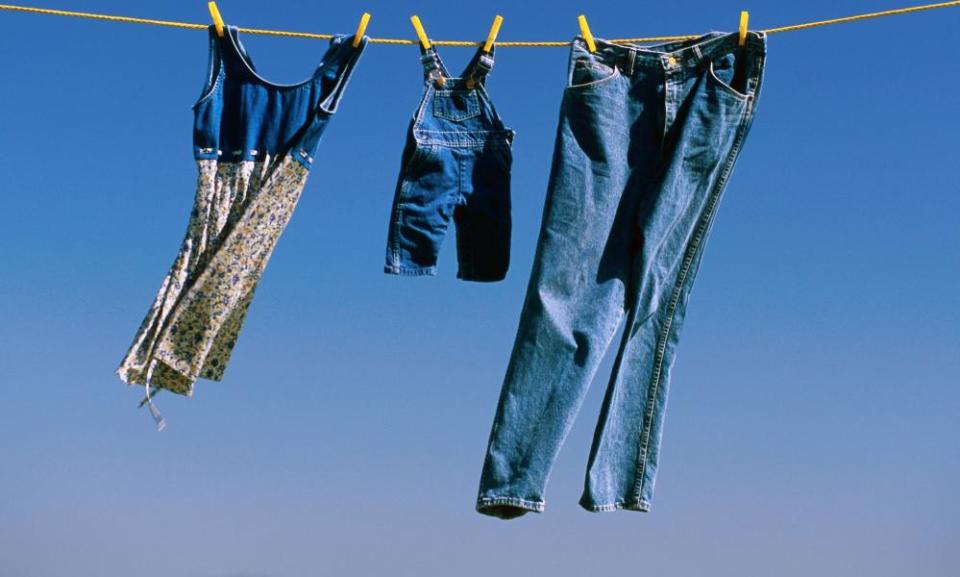Jean therapy: putting them in the freezer doesn’t work – so how do you make jeans last?

A stylist friend of mine often laments over poorly dressed but otherwise handsome men. “I wish they knew, all it takes is a good pair of jeans and a white T-shirt.”
The look dates back to Marlon Brando, who liked his jeans so tight, costume designer Lucinda Ballard said he had them sewn and taped to his body during the 1947 Broadway production of A Streetcar Named Desire. Unlike almost any other item of clothing, denim jeans have remained in style ever since.
But while jeans may not date, an individual pair requires the right kind of care and attention to enjoy the same longevity.
Wash cold and with care
Clare Henson, the product development manager for Nobody Denim, says to help your jeans retain their colour and shape, turn them inside out before washing them. Use cold water with a minimal amount of liquid detergent, and hang them out to dry. According to Henson, “tumble dryers are the enemy” because exposure to heat will “damage the fibres, shrink your jeans and speed up the ageing process”.
Related: Back from the shrink: how to rescue clothes that have shrunk in the wash
George Chan, a technical officer in the School of Fashion and Textiles at RMIT University, agrees. He suggests holding out as long as possible between washes and hand-washing in cold water to avoid “agitating the denim too much because you don’t want to wear it out”.
Pick pure cotton
Martin Kirby is the owner of Urahara, a specialty denim store in Melbourne with an onsite repair service. He says jeans made of 100% cotton are longer wearing than denim that has been blended with a synthetic fibre like elastane. “If they’re synthetic they tend to split and they’re much harder to repair,” he says.
He says jeans made from a heavy, rigid, 100% cotton denim with twin needle stitching and branded hardware like rivets and zips will last longest. Another thing to consider is selvedge denim, which has self-finished edges that won’t fray and is sometimes sold unwashed or “raw”.
Buy jeans that fit
According to Chan, often jeans split because people buy stretch denim, in a size down, so they look tighter. “This puts extra pressure on the fabric, especially where it’s rubbing between your legs when you walk,” he says. The combination of friction and tension, in a weaker synthetic-blend denim, causes jeans to deteriorate very quickly.
Chan says it’s important to try on jeans from different labels to find ones that are a good fit for your body. He suggests doing a bend test by sitting down or bending over “to make sure there is enough room in the rise at the front and the back so that the waistband stays on your waist”.
Kirby also advocates for a fit with a higher rise and a wider leg. Not only is this fit more comfortable, unlike with skinny jeans, “When you stretch your legs you don’t feel that pressure right in the crotch and because you have room on the thigh, you’re not splitting them all the time.”
Tears can be repaired
Instead of discarding jeans that have worn through at the thighs or acquired holes over time, Henson suggests “a good alterations place … can do wonders to make them look as though there’s no repair at all”.
This often requires specialty equipment. At Urahara they use something called a Singer 47w70 darning machine to do invisible repairs. Kirby says the machine can “access areas you can’t get to on a typical sewing machine. The fabric can be moved in any direction so you can recreate it the way it was woven originally”.
While invisible repairs require professional intervention, Chan says it’s possible to do DIY mending using patchwork and embroidery to cover holes and marks.
Myth busting
Related: Fit for purpose: how to save clothes that no longer suit your shape or lifestyle
Should you put your jeans in the freezer instead of washing them?
Chan says, “The idea is that the freezer kills the bacteria in the jeans and gets rid of the odour. It might work when you first take them out but it won’t be ongoing.” Though this rumour abounds online and has even been repeated by some denim manufacturers, scientists have repeatedly debunked it, saying household freezers do not kill bacteria.
Should you shrink your jeans by wearing them in the bath?
Henson says this comes from shrink-to-fit fabrics used in the 70s and 80s. Now “all our jeans are prewashed and pre-shrunk and thankfully don’t require this methodology”.
Should you wash your jeans at the beach?
According to Henson this is a “method used by some very hardcore raw denim addicts to create a unique pattern in the natural fade and crease areas on jeans” but it’s no longer necessary because these techniques are applied “in our denim laundry to give an authentic or worn look”.
Should you wait at least six months in between washes?
The jury is out on this; most experts recommend infrequent washing. In the interim, they suggest spot cleaning, airing jeans outside or using an organic fabric spray such as this one from Tangent.

 Yahoo Finance
Yahoo Finance 